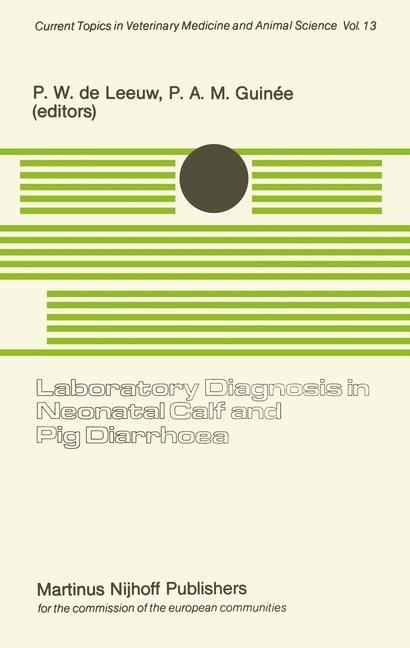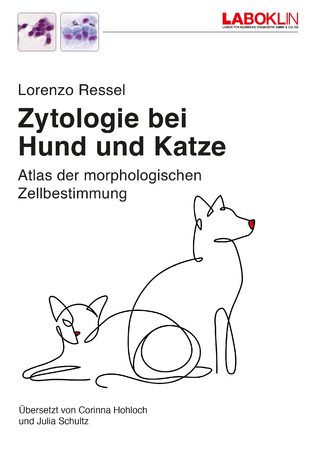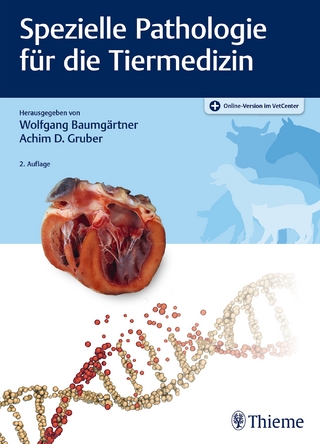
Laboratory Diagnosis in Neonatal Calf and Pig Diarrhoea
Kluwer Academic Publishers (Verlag)
978-90-247-2527-4 (ISBN)
- Titel ist leider vergriffen;
keine Neuauflage - Artikel merken
VIRAL AGENTS ASSOCIA1ED WIlli NEONATAL DIARRHOEA AND TIlEIR DE1ECTION BY ELECTRON MICROSCOPY M. S. McNulty, W. 1. Curran and J. B. McFerran Veterinary Research Laboratories, Stormont, Belfast, BT4 3SD, N. Ireland ABSTRACT Simple techniques for diagnosis of enteric viral infections by direct electron microscopy of faeces are described.
Enteric Viruses.- Papers presented.- Viral agents associated with neonatal diarrhoea and their detection by electron microscopy..- Cell culture techniques for the identification of enteric viruses — present possibilities..- Diagnosis by enzyme-linked immunosorbent assay..- Application of purified 5-aminosalicylic acid as substrate in enzyme-linked immunosorbent assay (ELISA)..- ELISA for the detection of rotavirus and rotavirus/antibody complexes in faeces..- RNA gel electrophoresis: a technique to monitor laboratory cross-contaminations and genetic reassortment amongst rotavirus isolates..- The neutralisation of the indirect immunofluorescence test and the immuno-diffusion test: two detection methods for neonatal calf diarrhoea viruses. A comparative study with ELISA and electron microscopy..- Comparison of diagnostic procedures for bovine rotavirus..- The diagnosis of Coronavirus-like agent (CVLA) diarrhea in suckling pigs..- Comparison of diagnostic techniques for research in neonatal diarrhea..- Laboratory manuals.- Agricultural Research Council’s Institute for Research on Animal Diseases, Compton, Nr. Newbury, Berks., U.K.:.- - Electron microscopy for the detection of bovine and porcine rotaviruses, bovine enteric Coronavirus, calicivirus-like agents and astroviruses in faeces.- - Detection of porcine and bovine rotaviruses in faeces by infectivity assay in cell culture.- - Detection of bovine astroviruses in faeces by infectivity assay in cell culture.- - Detection of bovine enteric coronaviruses in faeces by inoculation of trachea organ cultures.- - Rotavirus neutralisation test in cell culture by a fluorescent focus reduction test.- Station de Recherches de Virologie et d’Immunologie INRA, 78850-Thiverval-Grignon, France:.- 1. ELISA for the detection and quantitation of rotavirus in faeces.- 2. ELISA for the detection and titration of bovine anti rotavirus Ig in sera.- 3. ELISA for the detection of pig anti rotavirus IgG, IgA and IgM in faeces.- 4. ELISA for the detection of rotavirus/antibody complexes in porcine faeces.- 5. Neutralizing antibody plaque assay for bovine rotavirus.- 6. Detection of bovine enteric Coronavirus (BECV) in HRT 18 cells.- Central Veterinary Institute, Virology Department, 8221 RA Lelystad, the Netherlands:.- - ELISA for the detection of bovine rotavirus antigens in faeces.- - Haemadsorption-elution-haemagglutination assay (HEHA) for the detection of bovine Coronavirus antigens in faeces.- Central Veterinary Institute, the Netherlands and Institute of Medical Microbiology, University of Copenhagen, Department of Clinical Virology, EK-2100 Copenhagen, Denmark:.- - Immunoelectroosmophoresis (IEOP) for the detection of bovine rotavirus antigen in faeces.- Institute of Medical Microbiology, Copenhagen, Denmark:.- - Enzyme linked immunosorbent assay (ELISA) for the detection of rotavirus antigens in faeces.- National Institute for Veterinary Research, Groeselenberg 99, 1180 Brussels, Belgium:.- - Immunodiffusion test for the detection of rotavirus antigen in faecal material and gut homogenates.- - Neutralisation of the indirect immunofluorescence test (NIIF) for the detection of rota, corona and BVD-virus in bovine faecal material.- Laboratory for Virology, Faculteit van de Diergeneeskunde, B 9000 Gent, Belgium:.- - IF-test in the diagnosis of viral gastroenteritis in pigs.- Enteropathogenic E. Coli.- Escherichia coli associated with neonatal diarrhoea in piglets and calves..- This paper includes seven manuals: 1. Preparation of cultures, LT and ST for in vivo or in vitro assay.- 2. Assay of ST in the suckling mouse test.- 3. The ligated gut test (LGT) in pigs.- 4. Assay of LT in the Vero cell test.- 5. Production of the adhesins K88, K99 and P.- 6. A. Preparation of E. coli O, K and H antisera; a general outline.- B. Principles of serotyping E. coli.- C. Preparation of antisera for the detection of bovine and porcine enteropathogenic E. coli strains.- 7. A. Bacteriological techniques recommended for the detection of enterotoxigenic E. coli strains in calves in diagnostic field-laboratories.- B. Bacteriological techniques recommended for the detection of enterotoxigenic E. coli strains in neonatal and post-weaning E. coli enterotoxin induced diarrhoea (and oedema-disease) in piglets.- Adhesion of Escherichia coli pathogenic in pigs, calves and lambs to intestinal epithelial cell brush-borders..- Manual of the brush-border test.- Preliminary experiences with an enzyme-linked immunosorbent assay (ELISA) for the detection of the K88 antigen of E. coli in porcine faeces..- Manual of the K88 ELISA.- Hydrophobic interaction chromatography (laboratory manual)..- Miscellaneous.- Mixed diarrhoeal infection in calves: the relative importance of 2 interacting enteropathogens..- Piglet enteritis; field and laboratory evaluation of enteropathogens associated with 3 disease entities..- Cryptosporidiosis in calves: significance within the enteritis syndrome and diagnosis of infection..- List of Participants.
| Reihe/Serie | Current Topics in Veterinary Medicine ; 13 |
|---|---|
| Zusatzinfo | 210 p. |
| Verlagsort | Dordrecht |
| Sprache | englisch |
| Gewicht | 530 g |
| Themenwelt | Veterinärmedizin ► Klinische Fächer ► Pathologie |
| ISBN-10 | 90-247-2527-5 / 9024725275 |
| ISBN-13 | 978-90-247-2527-4 / 9789024725274 |
| Zustand | Neuware |
| Informationen gemäß Produktsicherheitsverordnung (GPSR) | |
| Haben Sie eine Frage zum Produkt? |
aus dem Bereich


